March 26, 2004
Air Date: March 26, 2004
FULL SHOW
SEGMENTS
Ancient Biowarfare
/ Adrienne MayorView the page for this story
Most historians will tell you the earliest evidence of biological and chemical weapons dates back to World War I and the use of mustard gas. But one historian has amassed a significant amount of earlier accounts that prove otherwise. Adrienne Mayor unearths histories of toxic honey, red-hot sand and stench weapons used throughout antiquity. She talks about these and other modes of ancient biowarfare in her new book, "Greek Fire, Poison Arrows and Scorpion Bombs: Biological and Chemical Warfare in the Ancient World." (12:45)
Security Risks Abound at U.S. Chemical Plants
/ Carl PrineView the page for this story
Forget biological stockpiles and nuclear arsenals. Take a look at the nation’s chemical industry, and you may find that the more than 2,000 manufacturing plants across the country could be the most vulnerable targets for terrorist attack. Reporter Carl Prine of the Pittsburgh Tribune-Review investigated dozens of plants in four major cities, and found numerous security flaws and little government regulation for facilities housing potentially dangerous and toxic chemicals. (16:20)
Emerging Science Note/Toxin Dangers
/ Cynthia GraberView the page for this story
Living on Earth’s Cynthia Graber reports that when two common pesticides were taken out of home use, infant birth weight increased. (01:20)
The Top Banana
/ Bob CartyView the page for this story
The banana is the perfect fruit. It’s sweet, it’s good for you, it isn’t messy, and you can tell when it’s ripe. But the banana’s history is far less sound; it’s been the cause of rebellions, and military coups, and, of course, a lot of bad jokes. And now, it seems, the banana as we know it could disappear. Bob Carty tells us all we want to know about this fruit, including the fact that it’s actually an herb. (15:20)
This week's EarthEar selection
listen /
download
Show Credits and Funders
Show Transcript
HOST: Steve CurwoodGUESTS: Adrienne Mayor, Carl PrineREPORTER: Bob CartyNOTE: Cynthia Graber
[THEME MUSIC]
CURWOOD: From NPR, this is Living on Earth.
[THEME MUSIC]
CURWOOD: I’m Steve Curwood. If you think biological warfare began with the threat of anthrax, think again. Ancient warriors who defied the Roman Empire often conscripted nature to help fight their battles.
MAYOR: They went out with terracotta pots and very carefully gathered stinging scorpions, whose sting can be fatal. And then they took them back to their fortress and they waited for the Roman siege.
CURWOOD: This week – a look at the biological and chemical weapons of the past and present. In the hands of an enemy, industrial chemicals, such as chlorine, could wreak mass destruction. And investigators say security at U.S. plants is lax.
PRINE: It got to the point where I was simply walking into plants, saying hello to workers on the way, even asking them, I mean, where are your most dangerous chemicals? And they would take me to them.
CURWOOD: The nation at chemical risk – coming up on Living on Earth. Stick around.
[NPR NEWSCAST]
ANNOUNCER: Support for Living on Earth comes from the National Science Foundation and Stonyfield Farm.
Ancient Biowarfare
CURWOOD: From the Jennifer and Ted Stanley studios in Somerville, Massachusetts, welcome to Living on Earth. I’m Steve Curwood.
Biowarfare is commonly regarded as a recent phenomenon. Smallpox martyrs, dirty-bombs and anthrax attacks are often assumed to be products of modern science. But new research reveals that our impulse to "weaponize nature" can be traced back more than 3,000 years. Some of these weapon systems were crude - others complex. And, from the very outset, the moral ambivalence over their use has mirrored today’s debate over deploying weapons of mass destruction.
Adrienne Mayor is a classical folklorist who has stockpiled a surprising amount of evidence of infectious and toxic warfare in antiquity. She's put it all in her book: "Greek Fire, Poison Arrows & Scorpion Bombs: Biological and Chemical Warfare in the Ancient World." Welcome to Living on Earth.
MAYOR: Thank you very much.
CURWOOD: Where did you get the idea to write such a book?
MAYOR: Well, you know, after 9-11 and the attacks with anthrax, I read all these editorials talking about the beginning of biological and chemical warfare. And every historian and every editorialist traced it to 1346, the Mongol invasion or siege of Kaffa in which plague-ridden bodies were catapulted over the walls. That’s a very famous incident. But I knew that the idea and the impulse for winning by unfair means and weaponizing nature must go back much further, and I just began to delve into my own files. And I keep files on marginal topics in classics – strange ways to die, diabolical weapons, things like that – and I was staggered by the amount of material I actually found.
CURWOOD: How do you do your research? Do you start with myths, or do you go to the historical record?
MAYOR: I started with myth in this case because I remembered the myth of Hercules and his labors. His second labor was to kill the Hydra monster, and “hydra” means water snake, poisonous water snake in Greek. But this Hydra was a monster, of course, fit for a hero to kill. And I remembered that he dipped his arrows in the venom of that monster after he killed the Hydra serpent. And therefore he had invented the first biological weapons. It was right there in ancient myth and no one had noticed the relevance to modern biological weaponry. Then I moved into historical literature, reading ancient historians and travel writers and geographers to find actual, real-life incidents of biological and chemical warfare.
CURWOOD: Help me get an idea of the kinds of bio-chemical weaponry that existed in antiquity. Could you perhaps start by explaining the title of your book? I mean, what’s “Greek fire,” what are “scorpion bombs”?
MAYOR: And not to mention poison arrows (laughs). Poison arrows were, in fact, invented by Hercules so I’ll start with those, actually. There were real-life warriors in antiquity that were encountered by the Greeks and other cultures. They were the Scythians. They lived in central Asia and they actually did dip their arrows in the venom of poisonous snakes and, thereby, creating a weapon that was a definite biological armament. And it meant that bravery against such weapons didn’t really count. The guy didn’t even have to be a good marksman; he could just nick you with an arrow dipped in snake venom and you’d die a gruesome death.
CURWOOD: And, indeed, wasn’t Greek Fire considered really horrific, that if you ran into this stuff in a naval battle that that was it, you’d be done?
MAYOR: The reaction in antiquity to Greek Fire has been compared to our reaction to the atom bomb. It was the most devastating, most feared and dreaded weapon of antiquity. It’s a combination of a weapon system and a devastating ammunition that was based on petroleum products. So it was made with naphtha, quick lime, and sulfur in a recipe that has been lost. But its effects were much like napalm. So it was a chemical weapon of mass destruction used in naval battles in the seventh century A.D.
Scorpion bombs, one of my favorite dastardly weapons of antiquity, were used against the Roman legionnaires in what is now Iraq, at the fortress of Hatra. The Romans were advancing on this fortified city -- they wanted to take it over because it controlled the caravan routes -- but the citizens of Hatra were ready. They went out with terracotta pots and very carefully gathered stinging scorpions whose sting can be fatal, and they probably threw in a lot of assassin bugs, as well. And then they took them back to their fortress and they waited for the Roman siege. And when the Romans began to scale the walls, they hurled the scorpion bombs down on the legionnaires. And this is one of the first times in Roman history that the Romans actually gave up a siege. They usually won a siege, even if it took a year. But, in this case, they withdrew.
CURWOOD: Now, let’s see. The ancient bio-chemical weapons you have come across – now, I’d say, what, fall into a few broad categories. We’ve got poisons and projectiles, incendiaries, contagions, even the drafting of animals and insects for war.
MAYOR: That’s right.
CURWOOD: What are some of the lesser known examples?
MAYOR: One of my favorites, a chemical incendiary, as red-hot sand that was used against Alexander the Great’s troops at Tyre in the fourth century B.C. The people of Tyre heated sand, and silicon actually has a very low melting point and can retain the heat. So they heated sand in shields over fires, and then catapulted a rain of red-hot sand down on Alexander’s troops. And this is a precursor to thermite bombs which explode tiny particles of metal and would have exactly the same effect. And that’s a sort of forerunner of an incendiary bomb.
CURWOOD: I want you to talk a bit about the “poisoner poisoned” theme that’s in your book. I’m thinking of those war elephants that trampled their own handlers sometimes during battle, or if you were an archer and you had a poison arrow and you nicked yourself.
MAYOR: The problems of what is now called “blowback” or “friendly fire” or “collateral damage” was envisioned as early as the Greek myths. Hercules died by his own weapons, many of his friends were wounded by poison arrows. There were problems with people using dangerous animals in warfare -- war elephants could suddenly run amok and trample their own side. People who used naphtha, which is a very volatile incendiary, certainly suffered a lot of blowback problems if the wind changed. And that would serve also for chemical weapons in the form of noxious clouds of smoke. So the problems of self-injury with biological weapons was recognized at the very earliest conception of such tactics.
CURWOOD: How acceptable was the use of biological weapons in ancient times?
MAYOR: There were always moral qualms about using biological weapons and chemical weapons, and taking unfair advantage. And people have, since antiquity, also had an idea about rules of war, proper rules of war.
The ancient Greeks, for instance, thought that projectile weapons were taking an unfair advantage. They thought that an archer would be – you could admire an archer for his marksmanship and skill, and yet they were not a model of bravery and courage, for instance. Because they shot from afar, never really putting themselves in danger. They were able to avoid face-to-face battle. There were certain rules of war in each society.
The other problem is that biological weapons are difficult to control, difficult to aim, difficult to avoid collateral damage and friendly fire. Therefore, that means that if you poison the well of a besieged city, for instance, you’re not just killing the combatants, you’re not just killing soldiers. You’re, in fact, killing the entire population of that city – that’s the women and children. So it becomes a weapon of mass destruction in very quick order.
CURWOOD: I’m just wondering if you could define bio-warfare for us. Most people seem to equate that with weapons of mass destruction, but I’m not sure that you do.
MAYOR: What all these modern weapons that we’ve been talking about and their ancient precursors have in common is that they allow the creator to weaponize nature, according to the best understanding of the day. And so, therefore, I am using a rather more expanded definition of biological and chemical warfare in my book. Not all of the ancient examples fit the strict definition of biological and chemical weapons that we use today. But they represent the earliest evidence of the principles and the practices that would evolve into modern biological and chemical warfare.
CURWOOD: What kind of research for war devices is going on now that really draws its inspiration from some of these weapons of antiquity?
MAYOR: In recent years, the Pentagon has wired rats to deliver explosives. They’ve used sea lions as sentinels, or even as assassins in the Gulf Wars. The Pentagon has enlisted bees and wasps as agents of war. The Pentagon has also unveiled some, what they call, “psychologically toxic armaments” which are designed by their bio-engineers. And these are devised to assault the senses of the enemy with intolerable odors and smells and sound waves that actually incapacitate people.
And yet, more than 2,000 years ago, armies in Asia had created a kind of poison arrow who’s smell was so intolerable and noxious that it was injurious to someone if it just whizzed by your face. The armies in Germany were able to create blaring noises using their shields as amplifiers to overwhelm the foe. So even stench weapons and acoustic weapons developed by the Pentagon have analogues in antiquity.
CURWOOD: You write that chemical weapons can have a shelf life of--what?-- a hundred thousand years? How do you put them out of harms way for generations of people who don’t want to use them?
MAYOR: The problem of how to destroy biological or chemical weapons once you’ve created them was actually contemplated in ancient Greek myth. Hercules, when he was struggling with the Hydra monster, had to keep in mind that the central head of this many-headed creature was immortal, could not be destroyed. So once he actually was able to kill the creature he had to do something with that head. And he hit on a geological solution. He buried it deep in the earth and put a gigantic boulder on top of it.
And if you just think for a moment about how we try to deal with the nuclear and chemical and biological weapons that we’ve created, once we don’t want to use them any more, once we want to destroy them, it’s very difficult. And we, too, have hit on a geological solution. We bury them deep under the ground and we hope that no one will ever dig them up. It’s a difficult dilemma. I think that once again here, the Hydra monster serves as a perfect symbol for the difficulties of dealing with the proliferating problems of biological warfare.
CURWOOD: Adrienne Mayor is a classical folklorist who specializes in the early history of science. She’s the author of “Greek Fire, Poison Arrows, and Scorpion Bombs: Biological and Chemical Warfare in the Ancient World.” Thanks so much for taking this time with me today.
MAYOR: Thank you very much.
CURWOOD: Coming up, a look at lax security in our nation’s chemical plants. An investigative reporter tells all about vulnerable facilities where dangerous chemicals are kept. Keep listening to Living on Earth.
[MUSIC: Terry Riley “Sun Rings” performed by Kronos Quartet LIVE RECORDING OF WORLD PREMIERE --2002]
Related links:
- Biological and Chemical Warfare in the Ancient World
- The Overlook Press
Security Risks Abound at U.S. Chemical Plants
CURWOOD: Welcome back to Living on Earth, I'm Steve Curwood.
Making chemicals in the U.S. is big business. There are more than 2,000 manufacturing plants nation-wide, and the chemicals brewed in these factories are used in everything from plastics to pesticides. These facilities have been operating for years with little in the way of security regulations. And since September 11th, some people worry that stockpiles at these plants could be turned into weapons for terrorists.
Carl Prine is a reporter with the Pittsburgh Tribune-Review, who tested the security of these chemical plants first-hand. Along with a camera crew from 60 Minutes, Mr. Prine took stock of dozens of chemical plants in four major U.S. cities. He reported his findings in a multi-part series for his newspaper. Carl Prine, welcome to Living on Earth.
PRINE: Hello.
CURWOOD: Tell me, what kind of chemicals, what kind of industrial chemicals do we have here in America, just briefly?
PRINE: Well, there are hundreds of very toxic chemicals that EPA regulates. The ones that are particularly dangerous are chlorine gas, phosgene, methylisocyanide – chemicals that actually have been used in the past as weapons in warfare.
CURWOOD: Now, how could one weaponize chemicals out of America’s industrialized plants?
PRINE: Well, sometimes it’s as simple as blowing a hole in the containment vessel. If you do that you’ll release a weapon of mass destruction.
CURWOOD: And what else might someone do?
PRINE: Well, there are other ways you could do it. You could try different reactive chemicals to set up a reactive process that will blow a containment vessel. Or you can mix certain chemicals in such a way as to create a particularly lethal gas.
Of course, in the past, people worried about terrorists stealing chemicals and then turning them into a weapon -- kind of combining them into a gaseous form and then releasing them. We thought we saw that in Om Shinrikyo’s attacks in Tokyo. But more recently, people believe that Al Queda, particularly -- since it has an interest in sowing mass destruction in a very limited area -- that probably a chemical plant itself would do the trick.
CURWOOD: Now, as I understand it, given the devastating affect that chemicals could have in an area, you and some other investigators decided to see just how easy or hard it might be for somebody who had, say, ill intent to get into a chemical plant with dangerous chemicals. What were some of the plants that you investigated?
PRINE: It ran the gamut. I mean, there were very small manufacturers and storage facilities that nevertheless stored catastrophic amounts of chemicals. And there were also major manufacturers, members of the American Chemistry Council, who have always said that their plants were the safest and that their security was the tightest.
Some of them were large ones, like the Ashland plant here in Pittsburgh, Neville Chemical, which is the one we did with 60 Minutes. But also ones people have probably never heard, like the KIK plant in Houston, which is actually a very small facility but they have enough chlorine on site to affect three million people. And when I say affect, I mean kill, injure, or displace.
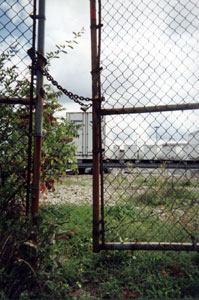 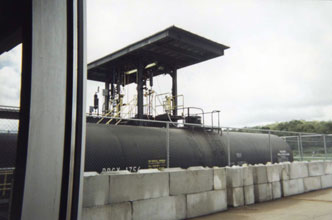 |
||
The Sony plant near Pittsburgh stores large amounts of chlorine gas, enough to kill, injure or displace more than 100,000 people in the suburban stretch of southern Pittsburgh. (Photo courtesy of Tribune-Review)
CURWOOD: Three million people? PRINE: Yes, and those figures are actually created by the industry itself. The idea is that they report to the EPA numbers that they think are likely in a worst case scenario. The idea is to prevent accidents. CURWOOD: What plan of action did you have in approaching each of these sites? I mean, did you sort of have a universal security test?
There was a Sysco plant in Chicago where one of the guards was asleep and I simply walked by. The Patapsco Wastewater Facility in Baltimore was the same way, where they actually had paid for a guard but the guard was sleeping. In fact, at the Chicago plant I actually woke the guard up on my way out and said “goodbye!” And he said “goodbye.’” CURWOOD: Tell me what you saw when you investigated one of these plants. Walk us into, say, Neville Island -- that’s a facility right in your town there of Pittsburgh that you investigated. PRINE: What we did is you simply walk along a rail line, it’s an unpoliced rail line. And you open a gate, or you walk through one of the many open gates, and you’re in. And it’s a very short walk from there to the boron trifluoride. CURWOOD: To the boron trifluoride? PRINE: Boron trifluoride – they use it in a reactive chemical process to make resins, plastic resins and things like that. It’s also been used in the past as an insecticide. So when it kills, it kills people much like it would an insect. CURWOOD: And how toxic is it? PRINE: It’s very toxic. That’s why it’s regulated by EPA. It would act like a gigantic roach motel if you were ever to get near it.
PRINE: There are none. There’s absolutely none – which is the point of a great deal of federal legislation that is going forward from both the Republican and the Democratic sides, to try to shore up shoddy security, years of bad security at chemical plants. CURWOOD: So, in other words, if I wanted to have a million gallons of highly poisonous chlorine gas compressed at my industrial plant, that’s just fine? I don’t have to worry about any regulations as long as it’s in an industrial zone someplace? PRINE: Exactly. And some cities have no zoning. Go to Houston and you’ll find a major petrochemical plant sitting right next to a suburban housing unit. I mean, it’s just the way of life there. Houston was one of the ones we targeted, and that was very scary, where you could simply walk up to a plant and realize that the school next door would be in the pathway of the toxic chemicals if they were released. CURWOOD: So Carl, somebody listening to this, and certainly me – I’m thinking, alright, these plants really sound vulnerable. What evidence has there been that chemical plants could, in fact, be likely terrorist targets? PRINE: Well, first of all, they have been terrorist targets in the past. There were a couple of white supremacist groups in California and Texas that tried to unleash toxic chemicals. One was propane and the other one, I believe, was chlorine gas. In the war in Croatia in the mid-90s, the Serbs actually targeted with their artillery Croatian chemical plants in an attempt to release it. Most recently in Israel, Israeli authorities are investigating an attack at a port facility there where they believe the suicide bombers were detonating so close to chemical tanks in an effort to release toxic chemicals. And the crazy thing is, we also know that Al Qaeda was targeting chemical plants. We know that Mohammed Atta had looked at a plant in Tennessee. And in the bunkers in Tora Bora and some other parts of Afghanistan, when they were overrun by U.S. troops, they discovered chemical industry plans that the terrorists had been looking at.
|

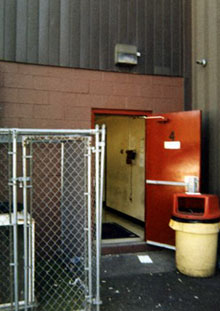 Open doors to warehouses allowed the Pittsburgh Tribune-Review reporter access to dozens of containers storing large amounts of anhydrous ammonia, a dangerous substance that doubles as a coolant, fertilizer and explosive. (Photo courtesy of Tribune-Review)
Open doors to warehouses allowed the Pittsburgh Tribune-Review reporter access to dozens of containers storing large amounts of anhydrous ammonia, a dangerous substance that doubles as a coolant, fertilizer and explosive. (Photo courtesy of Tribune-Review) 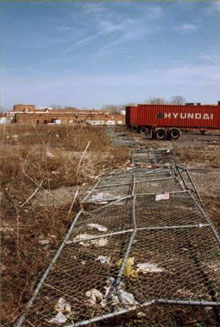 In the Chicago stockyards, dilapidated or broken fences allowed easy access to a number of major refrigeration complexes in the heart of the city. (Photo courtesy of Tribune-Review)
In the Chicago stockyards, dilapidated or broken fences allowed easy access to a number of major refrigeration complexes in the heart of the city. (Photo courtesy of Tribune-Review) 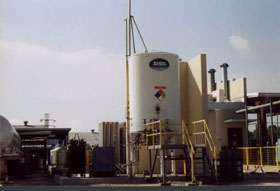 Airgas Specialty Gases in Houston was one of ten plants penetrated by the Tribune in Houston. Airgas stores large amounts of methyl chloride, a highly flammable, explosive gas that, when kindled, produces highly toxic phosgene and hydrogen chloride fumes. (Photo courtesy of Tribune-Review)
Airgas Specialty Gases in Houston was one of ten plants penetrated by the Tribune in Houston. Airgas stores large amounts of methyl chloride, a highly flammable, explosive gas that, when kindled, produces highly toxic phosgene and hydrogen chloride fumes. (Photo courtesy of Tribune-Review) 



